Have you ever thought about raising tadpoles? It’s easy! In this blog post we’re sharing how we set up our tadpole to frog tank so the girls could see the incredible metamorphosis first hand at home.
This is a fun and engaging way for kids to learn about the lifecycle of a frog and is a fabulous addition to a unit on lifecycles or mini beasts.
This activity was first published in 2016 and has been updated and reshared for today’s audience
You might also like our frog on a lily pad craft
Everybody knows that tadpoles hatch from tiny eggs and then gradually change into jumping amphibians with lungs and four legs But, knowing this and actually seeing it happen are two completely different things. As our macro photos will testify the changes and different stages they go through are completely fascinating to watch – and not just for kids!
It’s possible to set this activity up for next to no cost. I know this because when I was about the same age as my own kids (albeit with a little more freedom) my sister and I used to walk down a bush track near our house, ice cream containers in hand, and scoop little tadpoles from the creek to keep as “pets”.
We filled our containers half-full with creek water and added a large rock for the ones which made it all the way to becoming frogs. I clearly remember how excited we got to see them growing legs, and if you had a little froglet in your container it was the most exciting thing ever!
I wanted my own girls to experience the magic of watching this transformation happen with their own eyes, but unfortunately I can’t bring myself to allow them traipse off into the bush on their own to catch tadpoles. Luckily I don’t need to though because we have a small pond in our back yard that the local frogs love to visit to lay their eggs in.
We hear the frogs more than see them because they are very clever at camouflage and hiding, but we have been lucky to spot them a few times.
If you’ve never seen frog eggs they look a lot like caviar and float like bubbles on top of the water. Every so often we find a batch of them floating on the surface of our pond, but at the time of this project there were none so we caught a few baby tadpoles instead.
As I have already explained, you don’t actually need to spend any money to do this project if you don’t want to and the kids will delight in it just as much. However, we thought that observing the changes that happen would be easier in a proper tank which is why this time around, instead of using an ice cream container, I invested in a few items from the local pet shop.
To set up an observation tank just like ours this is what you will need…
For our tadpole tank we used:
- A plastic pet tank with a ventilated lid (medium size) – this is the kind of tank often used for pet mice or hermit crabs. We bought ours from our local pet supplies store but it looks exactly like this one here. It’s good to have the plastic lid because it allows in plenty of air but also stops them from hopping away once they get big enough
- A bag of washed river rocks
- A small water plant – we bought this on recommendation from the pet shop lady, and the frogs really seemed to love it. In addition to keeping their water healthy the plant also gives them a place to hide and lightly sit on once they have developed their lungs and need air to breathe.
- Some water conditioner to make the tap water safe for them to swim in (the same as what you would use for regular goldfish). I have also read that you can put a bucket of water outside to sit for a couple of days and it will do the same job but we were too impatient for that!
Our experience of raising tadpoles into frogs
Once we had the tank set up and ready to go the girls caught some tadpoles by scooping them up in plastic containers. They were so little at first, they must have been not long hatched out of their eggs.
As you can see we half-filled the tank and left some rocks and plant growth poking up from the top of the water. Once the tadpoles turn into froglets this is essential for their survival, but as young tadpoles they only need water and somewhere to hide. The large rocks we added came from the garden.
Feeding and cleaning the frog tank
Tadpoles are herbivores, so while they were small we fed them baby spinach leaves which had been rinsed and then microwaved on high for 20 seconds. Three leaves were enough to last a few days, and once they had all been eaten we added more. When they grew bigger they ate more and needed more frequent feeding.
When tadpoles become froglets they turn into carnivores, so they begin to rely on insects as their main source of food. Once our babies started looking more like frogs and less like tadpoles I began to add a scoop of living mosquito larvae from the surface of our pond into their tank as well as the baby spinach leaves.
I’m not a hundred percent sure if they ate the larvae or not because it took a long time to disappear. Still, it appeared to get eaten after a week or so of floating on the surface – either that or they turned into mozzies and flew off into our house!
At first the tank stayed clean for a long time and only needed scrubbing out every few weeks, but as the tadpoles grew bigger it got dirty quicker and this became a weekly task.
In order to clean the tank the girls helped me catch the tadpoles and place them in a container filled with a scoop of their tank water before completely emptying and scrubbing the dirty tank out. We added fresh tap water and more water conditioner before putting the tadpoles back into their home again.
Learn more about life cycles
Observing the tadpole to frog metamorphosis
Here is a tadpole which has grown back legs. Can you see his little arm forming beneath his skin?
Their skin was quite translucent which I had never realised before, so when we could see their tummies we could observe their intestines too! Notice how cleverly the tadpole camouflages himself to the pink sandstone rock in the image below.
It was truly interesting to observe and photograph the metamorphosis of these creatures.
Some of these photographs have been taken using my Canon DSLR and some are iphone snaps using an olloclip to get up close (a clip on macro lens, which is fun to experiment with).
Our tadpoles were all different sizes when we caught them so they were at different stages of development throughout the time that we were observing them. In total we had them in our house for around three months.
Once our tadpoles lost their tail completely we released them back into our pond. This was something the girls really loved doing!
Seriously, how cute are they!
Just in case you’re wondering, the frogs that we have been observing are striped marsh frogs which are common along the eastern coast of Australia and often found in suburban areas.
I’m not an animal expert at all so any questions I had whilst raising the tadpoles I directed them straight to my blogging buddy Penny from Mother Natured. She has also done this activity with her own kids and given away some of her valuable tips and knowledge here.
Have you kept tadpoles for observation before? Trust me, they’re more interesting to watch than TV – and I think even the kids will agree with that!
Setting up a tadpole tank
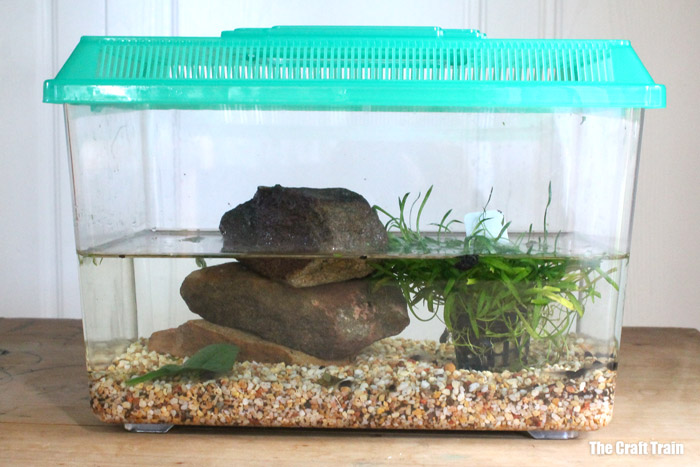
Materials
- Medium sized aquarium with a ventilated lid
- River rocks
- Aquarium plant (ask your pet shop which one suits frogs and tadpoles)
- Large rocks
- Water conditioner
- Wilted spinach leaves, for feeding the tadpoles
- Insect larve or fish food flakes for feeding the froglets
Instructions
- Wash the rocks and place them in the base of your aquarium
- Add a few large rocks for the frogs to sit on and the tadpoles to hide under
- Add tap water, measuring how many litres you are adding as you go. Fill so the tank is half filled with water and there are large rocks poking above the surface
- Add water conditioner to make the tap water safe for frogs. This can vary for the brand you are using so follow the instructions on the bottle for the amount of water in your tank
- Add an aquarium plant
- Add tadpoles
- As soon as the tadpoles have become tiny frogs, release them into their natural environment. It can take a full year for them to then turn into an adult sized frog
Notes
Feeding the tadpoles:
Rinse a few baby spinach leaves in tap water, then microwave on high for 20 seconds. Allow to cool before feeding them to your tadpoles. Once the spinach leaves have been eaten, add more. Initially this can take days, but as the tadpoles grow they eat more.
Feeding the froglets:
Frogs are carnivores and eat insects not leaves. You can catch live insect larvae by scooping it up from the surface of a pond or feed them flakes of fish food
More frog crafts and activities
- Make a bouncy frog on a lilypad paper craft
- Create a cute paper roll frog using this squish, cut and fold technique
- Set up an outdoor frog habitat succulent garden
- This paper frog craft has been based on the Green Tree frog species from the Daintree Rainforest
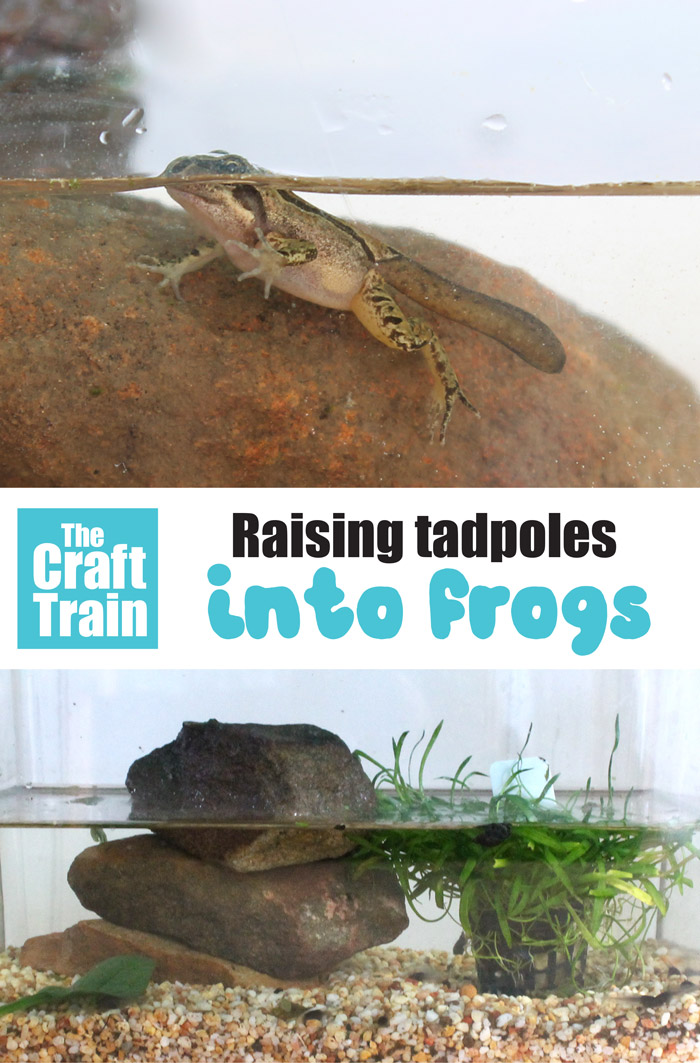
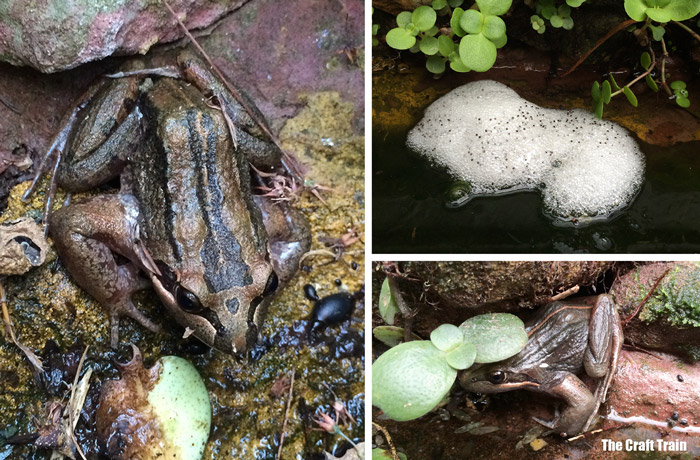
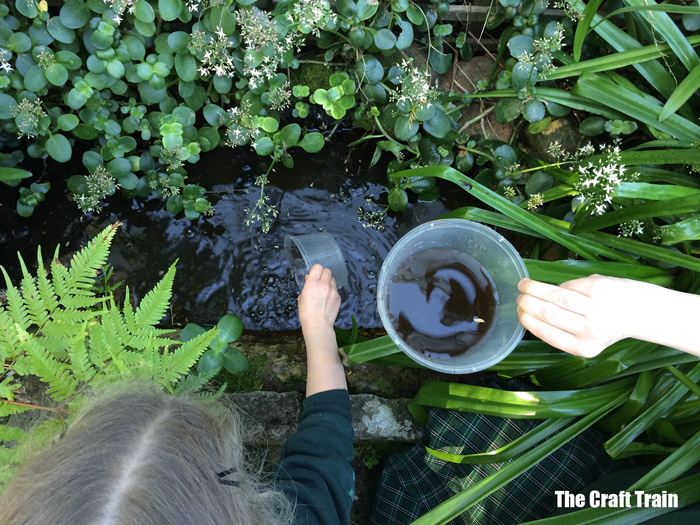
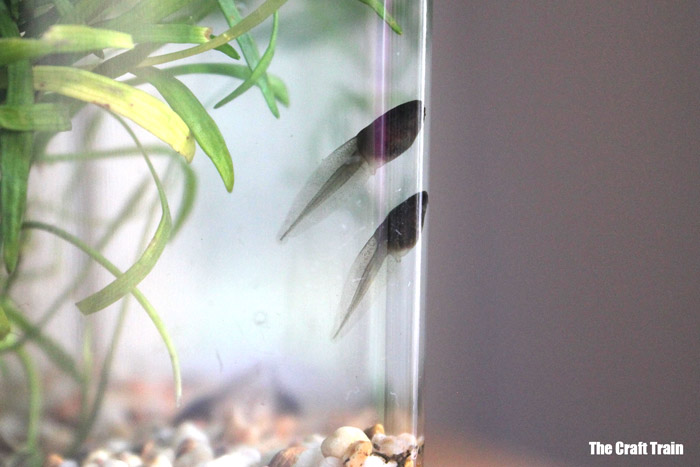
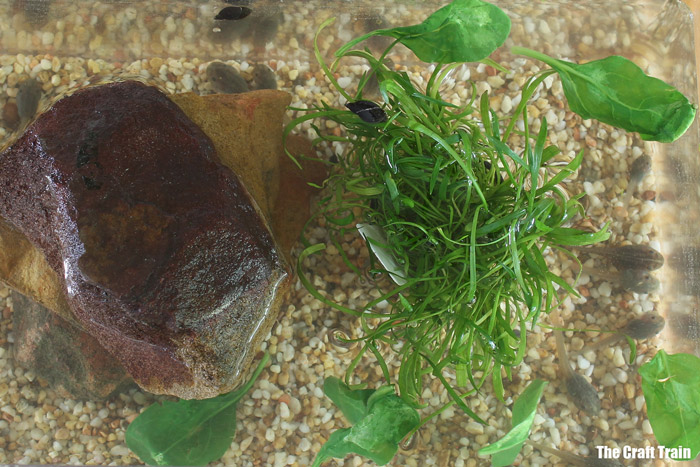
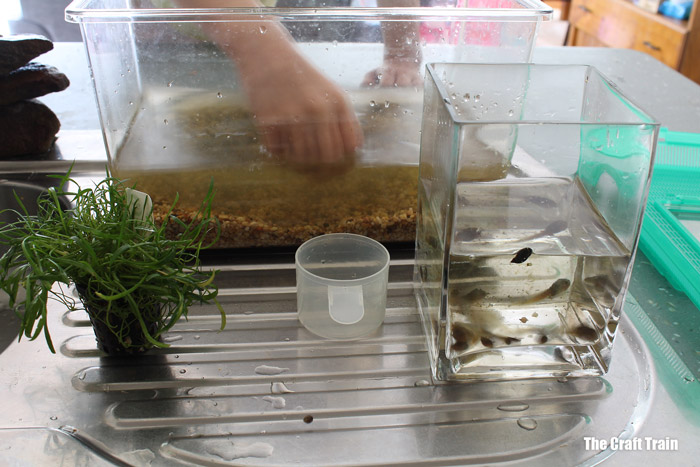
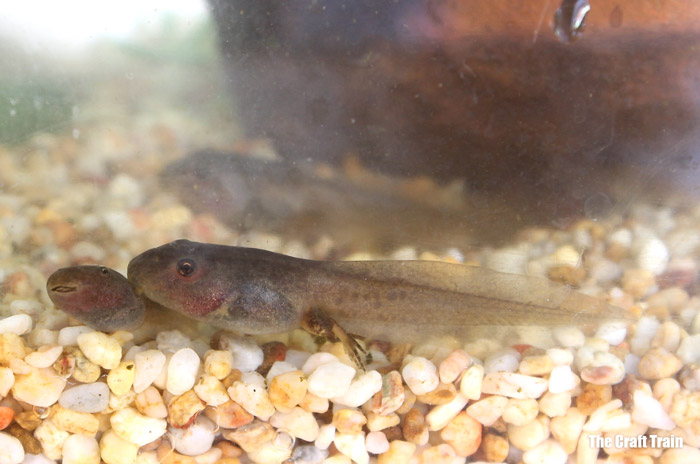

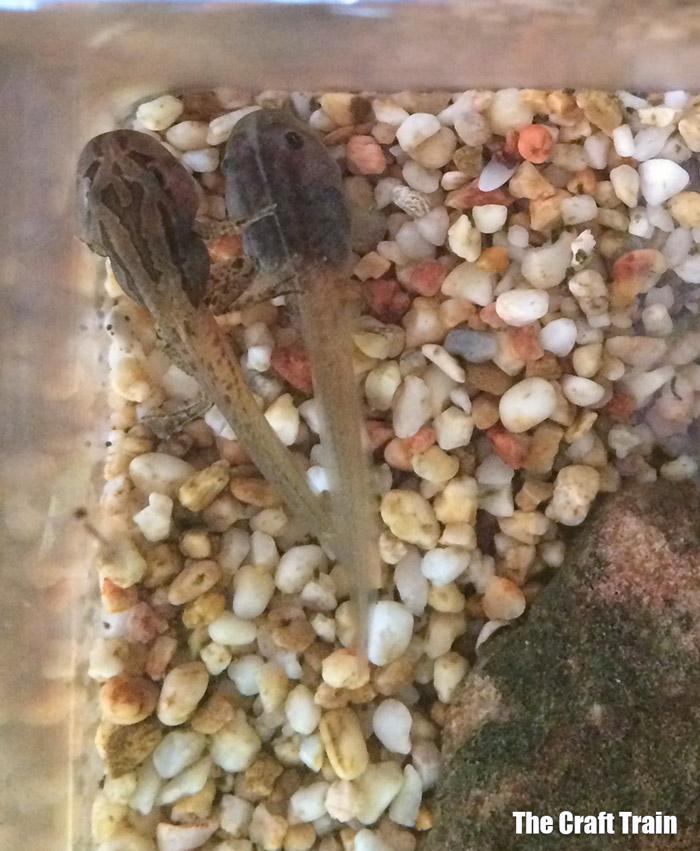
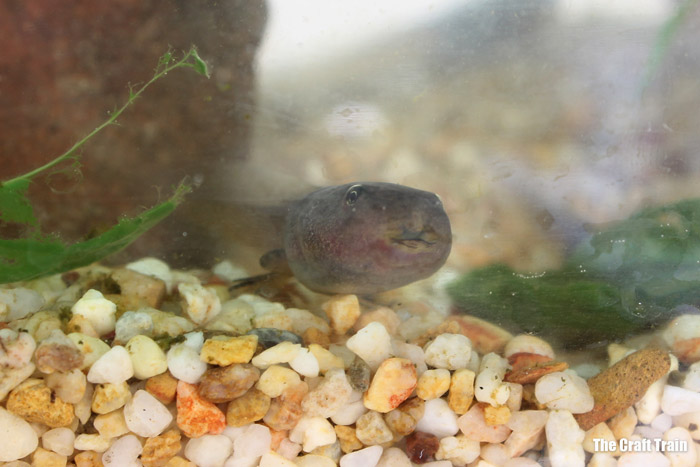
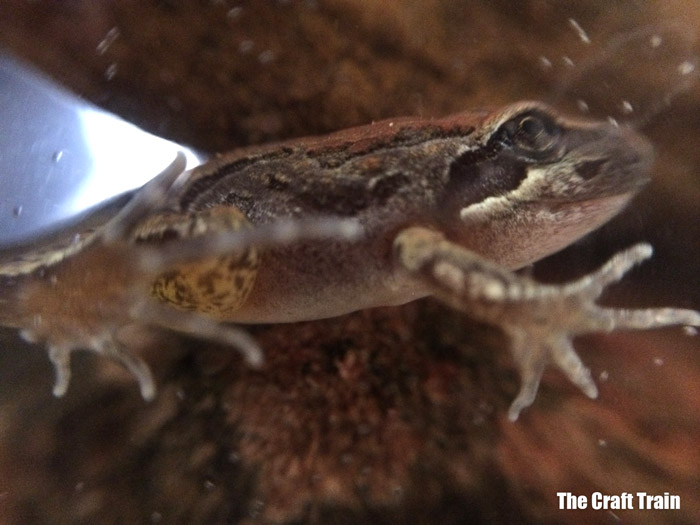
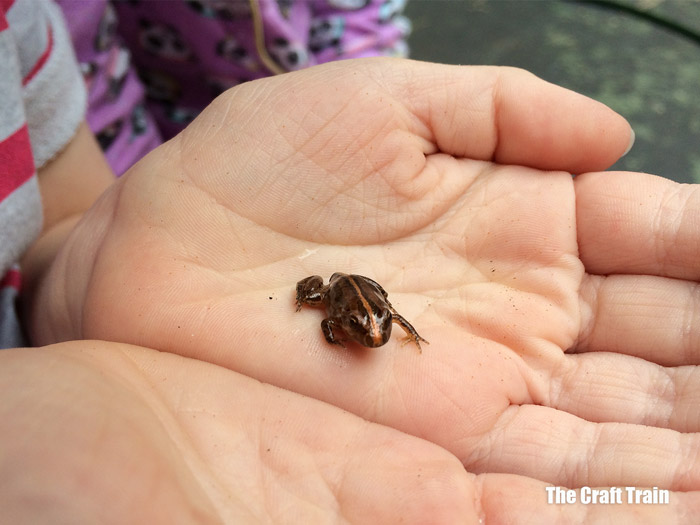

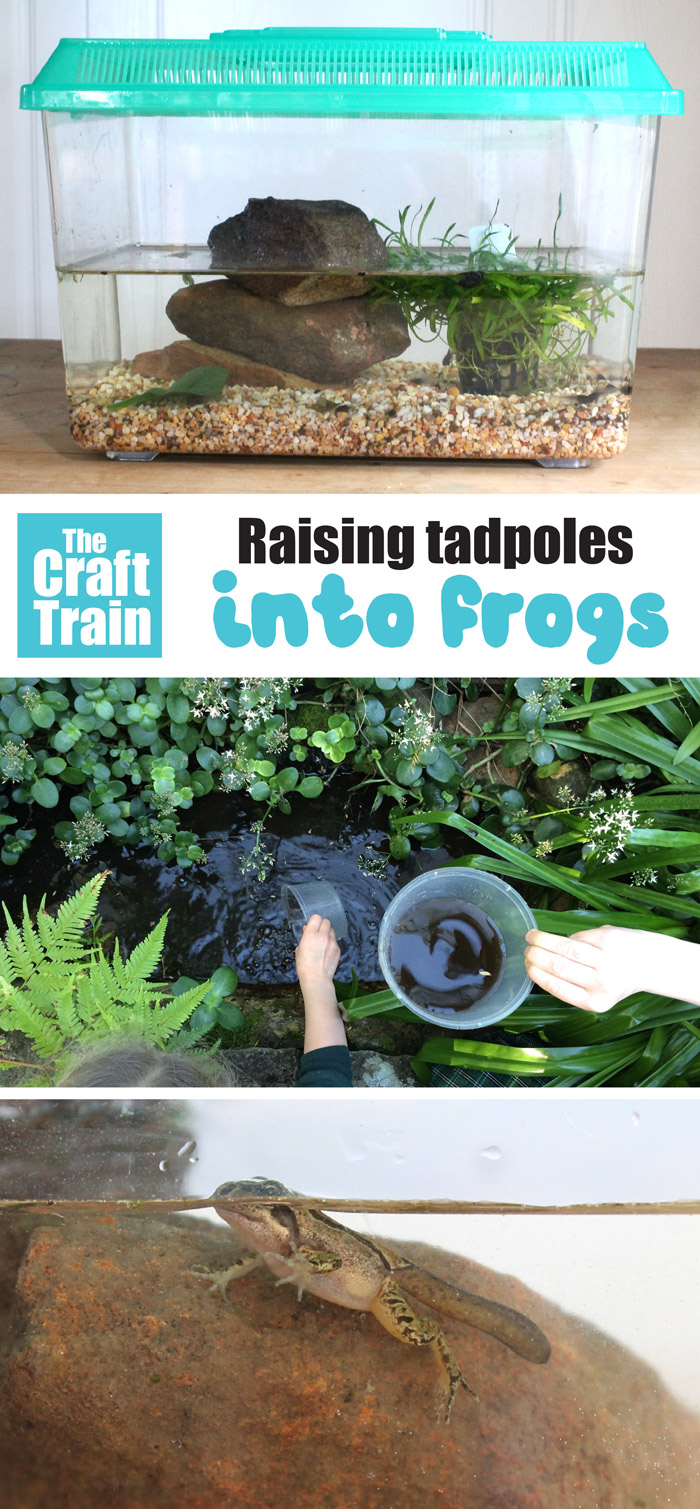

Hi, I have a aquatic frog should I have a rock for it to sit on
Or is it better to just keep in the water all the time thank you!
Hi, I really don’t know about that particular breed of frogs. As I mentioned in the post I am not an animal expert just a mum who wanted her kids to see frogs develop from tadpoles in a tank. Based on my limited experience and the breed of frogs we observed, they love to have rocks both as somewhere to hide as well as something to sit on to breathe air.
Thank you for this my daughter and I are raising bull frogs it’s hard to get information that is clear our bull frogs is just getting legs and we are do excited I asked a pet shop about a plant and no one could answer my question do thank you again
Glad our article helped 🙂
I have african dwarf frogs and they just go to the top to get a breath, and just hid the rest of the time. I put live plants in so they could hide. I live in Alaska. These tropical frogs are a lot of fun.
You should have a platform or rock that your frog can get up on. They can drown. Yes even though they are frogs. We are raising tadpoles and I read were they must have a spot to get out of water. Good luck…
You are right, that is very important. When our tadpoles began to develop legs we made sure there was a rock poking out of the water for them to sit on and rest.
How do you know the tadpole species you are collecting are least concern rather than any other status which is illegal? You can only collect least concern eggs, tadpoles and frogs from your own property and have no more than 8 adults at a time. Also regarding your other comment frogs don’t have breeds they have species. Also you are holding a frog with dry hands it seems in that picture which is bad for them as they breathe through their skin and you can remove the protective slime coating they have
Hi there. Thanks for the info, I don’t pretend to be an expert on frogs – I’m not. With this project I was merely encouraging my girls to appreciate frogs and learn more about their transformation by observation. In answer to the species question, I learned that these frogs were striped marsh frogs by looking them up and finding images on Wikipedia which look exactly like the ones which mature in our backyard pond, which is where we collected the tadpoles (not eggs) from. As soon as they were able to hop we released them back into the pond.
Thanks to Kate for sharing a great project. “Lily” the Liberal can go to hell..!
Thank you for all the crafts you share with us.. I am a Grandmom raising a 9 year old granddaughter and we have done so very many of your crafts.
This tadpole experiment will be no different and I appreciate all the information .Hoping that One comment from Lily will never get you so aggravated as to not do this any more..
THANK YOU AGAIN…for sharing thru the years.
Mom-MomChrissy
Lily seems to have forgotten that is a great way for children to learn about animals. Kate mentioned they took the tadpoles from their own pond not from any public parks. It seems Lily is a negative person who has nothing better to do than write complaints about how people handle frogs and from where they get them. What are you, the frog police? Get a hobby Lily, instead of doing this to a great post. Thanks Kate for your efforts.
Yes, AGREED!!!
I TOTALLY agree!! ❤…this is a great article/post!! I enjoyed it so much that I shared it with my son n daughter (20 &17)…never too old to have fun! we just caught 12 tadpoles in our swimming pool that we are late opening this year, we tried to save as many as possible! I especially enjoyed how she set up their tank! thanks kate…GREAT job!! 🐸…and ignore ignorant, rude, superior thinking individuals ( I worded that as carefully as I could)…because I’m sure kids will be reading this. kids?…”lily” is who you DON’T want to grow up like!! 🐸🐸😂
Wow SERIOUSLY? A mom simply shared a cute project that was a great learning experience as well and you come and berate her. OMG there is no shortage of RUDE people and ignorance. I think she did a fabulous job! I never understood why CERTAIN types of people always feel the need to interject some hate into something. A good rule is IF YOU DONT HAVE ANYTHING NICE TO SAY THEN SHUT UP. This mom made it clear she was no expert many times but you still felt the need to remark? These type of people (meaning you) think it makes them somehow feel superior when it actually makes you look the fool you are. I am currently doing this project with my granddaughter and this article was one of many I read that played a part in my set up. SHAME ON YOU! NO REALLY, SHAME ON YOU!
this is sooooo helpful!! thank you!
you’re welcome!
THANK YOU!!! My kids just found tadpoles and this was extremely helpful! Can you tell me approximately how many tadpoles you kept in that size habitat? My kids caught way more then we can raise and I’m trying to figure out how many to return to the pond!
I think we had around 10 but it was a while ago so I can’t remember for sure.
how many tadpoles did you keep in the tank
About 10 from memory
Did you have the tank inside the house or leave it outside?
We kept it indoors
What if you don’t have water conditioner for it and you can’t buy it?
You can also leave the water outside in the sun to sit for 24 hours (I’ve read). They should be OK. We top up our frog pond with tap water regularly.
Hi, I know this post was from a while back. However, kindly, the comment that stated “how do you know you collected a species of least concern” I wanted to ensure to note the need for our future generations to learn about and appreciate frogs in order to protect them. The earths best advocates are those we put initiative into assisting them to learn.
Julie, I couldn’t agree more! I have a tadpole aquarium now that I am “helping” my 6 year old granddaughter with. We have had a blast and we both have loved the experience of tending these babies, no matter their species!
Like Kate, we will release them back into my water garden as soon as they mature which for several, won’t be long!
Sincerely, Sheila
I love tadpoles! Like so much! I have a lot of them in my pond! LOL!!!
can tadpoles jump like frogs? I have wondering for a long time and i still do not know. It’s crazy! super crazy!
I searched and found your great article, so thank you! I remember catching tadpoles in a creek with my best friend when I was 10, and today my 12-year-old daughter just found a creek with tadpoles near our house, so we are totally doing this! I’m so excited, and thank you for your great tips! We are looking forward to releasing the froggies back to the creek when it’s time!
Thank you for your feedback, I hope your daughter has fun with the project 🙂
Did you have the tank inside or outside? We have eggs in our pool and before we get it going for the year I want to try to set up a tank for the kids but don’t really have a good area inside for it so was wondering if outside would be okay??
I don’t think it would be a problem
Hi 🙂
Great article.
Best regards from Norway.
how big should the tank be?
Ours is a medium sized critter keeper (we no longer have it though so I can’t measure it for you). If you use a smaller tank just put less tadpoles in there.
how many tadpoles did you put inside i have one half the size
I can’t remember exactly, because we did this project a few years ago. As a rough guide you should aim for 5-10 tadpoles per litre of water.
Thank you for your post. We had an empty pool that had collected rain water and one day saw a frog inside. Next day the frog was gone a d a few days later found frog eggs in our pool. We scooped some out with some of the water and put them into a large plastic bowl with a rock and some plants we pulled up from next to the pool. My 9yr old daughter is so excited to watch them grow. I was searching how to take care of them and found your post. The eggs have already hatched and the tad poles have grown some. It’s been almost a week. Can’t wait to see all the changes to come. Thank you for all the great tips.
Thank you so much for sharing. My husband and I turned our pool pump off while we were on vacation for 7 days. When we got home we found what seemed to be hundreds of tadpoles. So, before we replaced the chemicals my husband and I suited up and got into the creek that once was my pool and captured as many of the tadpoles for 2 days. I placed them into a baby plastic pool and then we bought a fish tank and brought about 20 inside so our grand children could watch their amazing transformation. They are all different sizes as well. I do believe I am more excited at this point than my grandchildren are. Thank you again for your article and all the great tips/ideas that you found to be successful.
Aw, that’s so sweet that you rescued all the tadpoles! I hope the grandkids (and yourself too) enjoy the transformation.
I am currently raising about 30 tadpoles from our pond. When our waterfall pump leaked and lower the pond level, we removed the plant pot the tiny tadpoles were in as it was above the water level. I put it in a wash basin with enough pond water to keep them swimming. They are outside in a shady area. I’d put them back in the pond but I’m sure the fish would eat them. And it’s so much fun to watch them. It’s been about a month now and a few have developed hind legs. I’ve been feeding them algae, pond plants and fish pellets. For anyone wondering about what water to use I suggest natural sources, i.e. a pond, creek or rain.
Sounds fascinating 🙂
Can you buy the spinach and just drop into the tank? (after the 20 second micro instructions)??
These tadpoles just showed up in a bucket of water I had sitting outside!! Should I use this water in the little tank?
The water they’re already in is perfect. I just used shop-bought baby spinach
I work in a nursery school, frogs laid their eggs in my pond at home so I took a few to the nursery… it was going really well until they started to turn in to baby frogs.. so far 3 of 5 of the ones that have turned into baby frogs have died the day after their tail was absorbed..
Any advice? I half wonder if it could be that they get disturbed and jump back in the water so are ‘drowning’ as not getting enough out of water time.. please help..!!
I appreciate your blog itself is years old but you seem to know what you’re talking about.
That’s so sad! Poor frogs. Do you have a rock poking above the water for them to sit on so they don’t get tired? Also, are they eating? Adult frogs eat insects (or you can give them fish food).
With ours, we released them as soon as their tails were gone.
Hi, I know this article is old, so I hope this gets to you. Should I clean my tadpole/frog container before use and if so, how?
Thank you so much!
-Cara
I would clean it with warm water. It can be soapy so long as you rinse all the soap away before adding the clean water for your tadpoles